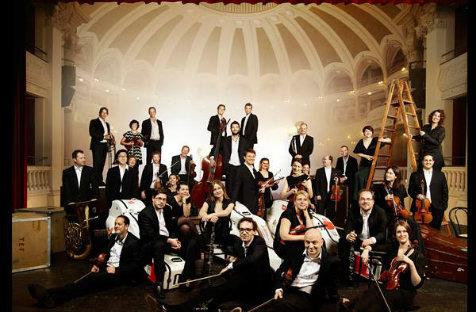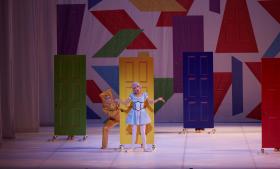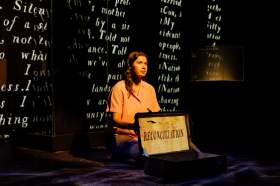The Mahler Chamber Orchestra is international cooperation at its creative best. Comprising musicians from over 18 different countries, including two Australians (violinists Kirsty Hilton and Michael Brooks Reid), this eagerly awaited orchestra began its first Australian tour with a diverse program and a brilliant soloist. A further enticement for the capacity audience was a venue that provided the perfect setting to display the formidable talents of both orchestra and soloist to best advantage. It was an ideal partnership.
The string section was the first to be put through its paces with an arresting account of Henze’s Sonata for Strings, a sonata in two movements. It was clear from the outset that here was a body of musicians that was at one with itself and its conductor. From the initial attack of the first movement to the more lyrical and atomized passages of the second movement, the string sound was always finely controlled and splendidly integrated. At one point the transition from the cello principal to the first violins was eerily seamless. Their ability to blend and render detailed nuance, as well as provide a dynamic range from a just audible pianissimo to the robust climax that marked the end of the piece, served Henze’s musical intentions admirably. It was most gratifying to hear a work that has relatively few airings played so convincingly.
Alisa Weilerstein has already developed a following in Australia due to previous engagements in 2001 and 2011 with former ABC orchestras as well as recordings. It is little wonder that in 2010 she became the first cellist in over 30 years to be signed up by Decca Classics as an exclusive recording artist. Her reading of Shostakovich’s Cello Concerto No. 1 fulfilled all expectations on Wednesday night.
Dressed in a strapless, full-skirted, deep rose gown, she seemed to embrace the cello so that it became an extension of her body. On the foundation of a rock solid technique, Weilerstein’s music making was simply thrilling. The high tensile passages of the first movement certainly had my spine tingling and later deeply emotional passages were given sufficient depth of passion to induce a damp eye. The heartfelt, lamenting theme in the second movement, based on a Jewish folk song, was played with grace and sensitivity.
From passages demanding incisive energy Weilerstein was able to turn to the most delicately plaintive harmonics with ease. Her enormous range of musical expression was perhaps most remarkably demonstrated in the extended unaccompanied cadenza, which constitutes most of the third movement. An immaculate technique was always at the service of imaginative and impassioned musical eloquence. The climax of the final movement was nothing short of breathtaking.
In some respects it was a pity that, after such an experience, an encore was played in response to sustained applause. The inevitable choice was a movement from a Bach suite. It was beautifully played, but such is the power of Shostakovich’s masterpiece that I for one would have preferred it echoing in my memory uninterrupted.
The same could also be said of the orchestral encore that followed Dvorak’s ‘New World’ Symphony. The final timpani beats and the dying sounds of the brass at the end of the symphony made such an effective emotional connection with the longing and lingering of the ‘Going Home’ theme, played so beautifully on the cor anglais by Emma Schied, that that is just what I wanted to do: go home without further ado. It was another experience to be savoured.
The choice of this symphony after two less well-known works was a happy one as it enabled the audience to listen with more attention to interpretation and the characteristics of individual players. Again, Daniel Harding and the orchestra demonstrated a remarkable unity of purpose, whereby the players seemed to breathe together and give the music elasticity and nuance. It is wonderful to hear new details in a performance of a work that is extremely familiar. The wooden flutes in particular, with Chiara Tonelli as an admirable principle flautist, produced a most appealing warmly textured sound.
In fact, the Mahler Chamber Orchestra has many players capable of the finest articulation and musical expressiveness. It is to be hoped that this is the first of many visits to Australia.
Rating: 4 ½ stars out of 5
Mahler Chamber Orchestra
Alisa Weilerstein, cello
Daniel Harding, conductor
Program 1
Hans Werner Henze – Sonata for Strings
Dmitri Shostakovich – Cello concerto No. 1
Antonin Dvorak – Symphony No. 9 ‘From the New World’
Melbourne Recital Centre
12 June





